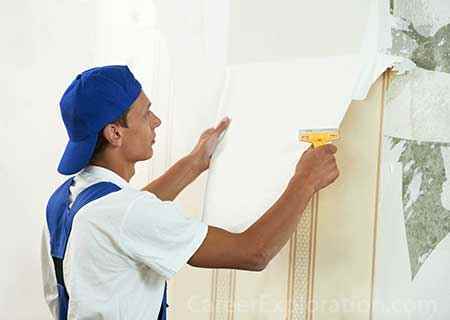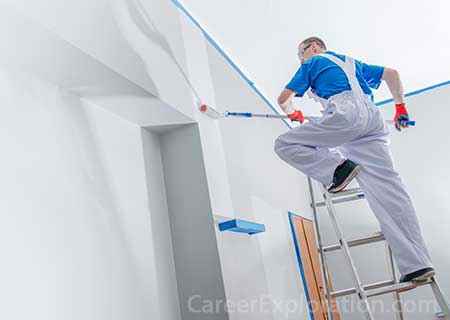
Painters apply paint, stain, and coatings to walls and ceilings, buildings, bridges, and other structures.
What Do Painters and Wallpaper Installers Do?
Duties
Painters typically do the following:
- Cover floors, furniture, and trim with drop cloths, tarps, and masking tape to protect surfaces
- Remove and replace pictures and outlet and switch covers
- Install scaffolding and raise ladders
- Fill holes and cracks with putty or plaster
- Prepare surfaces by scraping, wire brushing, or sanding to a smooth finish
- Calculate the size of the area to be painted and the amount of paint needed for the area
- Apply primers or sealers so the paint will stick to the surface
- Apply paint or other finishes, using hand brushes, rollers, or sprayers
Paints and other sealers protect surfaces from damage caused by weather, sunlight, and pollution.
There are several ways to apply paint to a surface, and painters must choose the correct tool for each job, such as a roller, power sprayer, or brush. Choosing the right tool typically depends on the type of surface to be painted and the characteristics of the paint to be used. Some employers require painters to provide their own equipment.
Painters may wear special safety equipment for a job. For example, painters working in confined spaces, such as the inside of a large storage tank, must wear self-contained suits to avoid inhaling toxic fumes. Some painters wear additional clothing and protective eyewear when operating abrasive blasters to remove old coatings. When painting bridges, ships, tall buildings, or oil rigs, painters may work from scaffolding or harnesses.
Career Snapshot
Painters paint a variety of objects from equipment, walls and buildings to bridges and other large structures. They use different types of tools and equipment from rollers, brushes and spray guns to ladders, scaffoldings and harnesses. A painter career includes removing old paint through sanding or wire brushing to prepare surfaces for new paint, protecting floors and furniture with drop-cloths, setting up ladders or scaffolding and filling cracks or holes in walls with putty or similar fillers.
Painter jobs may be divided into further job sub-sectors such as:
Painter Decorative – These painters coat or decorate articles such as furniture, glass, plate ware, pottery, jewelry, toys, books, or leather.
(Decorative painters may also have these job titles: Decaler, Decorator, Glass Decorator, Glazer, In Mold Coater, Painter, Pottery Decorator, Silk-Screen Operator, Spray Painter, Sprayer)
Painter Construction – These painters apply paint, stain, and coatings to walls and ceilings, buildings, large machinery and equipment, and bridges and other structures.
(Construction painters may also have these job titles: Facilities Painter, Foreman, Highway Painter, House Painter, Industrial Painter, Journeyman Painter, Maintenance Painter, Painter, Painter Foreman, Senior Painter)
Wallpaper installers typically cover interior walls or ceilings of rooms with decorative wallpaper or fabric, or attach advertising posters on surfaces such as walls and billboards.
(Wallpaper installers may also have these job titles: Bill Board Poster, Bill Poster, Hanger, Paper Hanger, Paperhanger, Vinyl Hanger, Wall Covering Contractor, Wall Covering Installer, Wallpaper Hanger, Wallpaper Installer)
Job Details
Painter and Wallpaper Installers typically:
- Cover floors, furniture, and trim with drop cloths, tarps, and masking tape to protect surfaces
- Remove and replace pictures and outlet and switch covers
- Install scaffolding and raise ladders
- Fill holes and cracks with putty or plaster
- Prepare surfaces by scraping, wire brushing, or sanding to a smooth finish
- Calculate the size of the area to be painted and the amount of paint needed for the area
- Apply primers or sealers so the paint will stick to the surface
- Apply paint or other finishes, using hand brushes, rollers, or sprayers
- Remove old materials or prepare surfaces to be papered
Education and Experience
A high school diploma or equivalent is typically required to enter the occupation. There are no formal education requirements to become a painter. Some technical schools offer optional certificates in painting.
Career Outlook
- Annual pay: The average salary in May 2019 was approximately $40,000
- Employment growth forecast 2018-2028: 6%
- Entry-level education: No formal education credentials
Career Growth Opportunity
The expected increase in new construction activity will continue to create a need for painters (both construction and decorative) and wallpaper installers. Investors who sell or lease properties also will require painters’ services.
Professional Associations
- International Union of Painters and Allied Trades – IUPAT members work in the Finishing Trades as industrial and commercial painters, drywall finishers, wall coverers, glaziers, glass workers, floor covering installers, sign makers, display workers, convention and show decorators and in many more exciting occupations.
- Painting and Decorating Contractors of America - PCA is a national trade association dedicated to the success of painting and decorating contractors through ethics, education and excellence.
- Home Builders Institute - This organization’s mission is to advance and provide education, career development, training and placement of men and women serving the building industry.
- Wallcovering Installers Association - WIA assists members with many things: continued education, information resources, networking opportunities, small businesses management assistance and exposure of the craft to the consuming public
- National Association of Home Builders - NAHB strives to protect the American Dream of housing opportunities for all, while working to achieve professional success for its members who build communities, create jobs and strengthen our economy.
- The Society of Decorative Painters - This organization represents a global community for painters and aspiring artists whose mission is to share ideas, develop skills and participate in a fun, creative environment. The society recognizes diversity and excellence in all styles of painting.
- Wallpaper History Society - The Wallpaper History Society provides a unique forum for wallcoverings enthusiasts and professionals alike. The Society, which is a registered charity, celebrates the history, design and social relevance of historic and contemporary wallcoverings and promotes both their study and that of the many trades and professions associated with them.
- The Associated General Contractors of America - The AGC of America works to ensure the continued success of the commercial construction industry by advocating for federal, state and local measures that support the industry; providing opportunities for firms to learn about ways to become more accomplished; and connecting them with the resources and individuals they need to be successful businesses and corporate citizens.
- National Association of the Remodeling Industry - NARI connects homeowners with its professional members and provides tips and tricks so that consumers have a positive remodeling experience with a professional, qualified remodeler.
- National Center for Construction Education and Research (NCCER) - This mission of this organization is to build a safe, productive and sustainable workforce of craft professionals. Their vision is to be universally recognized by industry and government as the training, assessment, certification and career development standard for construction and maintenance craft professionals.
- The Associated General Contractors of America - The Associated General Contractors of America works to ensure the continued success of the commercial construction industry by advocating for federal, state and local measures that support the industry.
Publications
- Paint Magazine - Paint TV, Paint News, Paint Topics, Paint Radio
- Paint Pro Magazine - This magazine has digital archives featuring over eight years' worth of valuable how-to information on decorative concrete, faux finishes, and painting and decorating techniques.
- The Decorative Painter - Published quarterly, the magazine features traditional and emerging painting lessons and projects from the industry’s leading artists and teachers.



